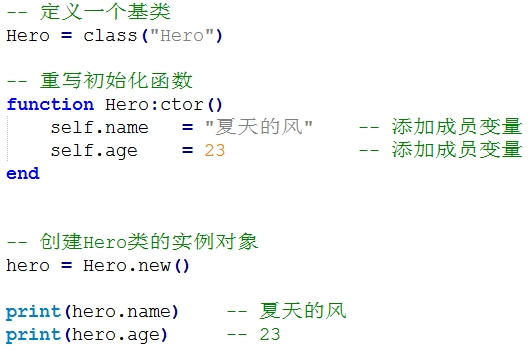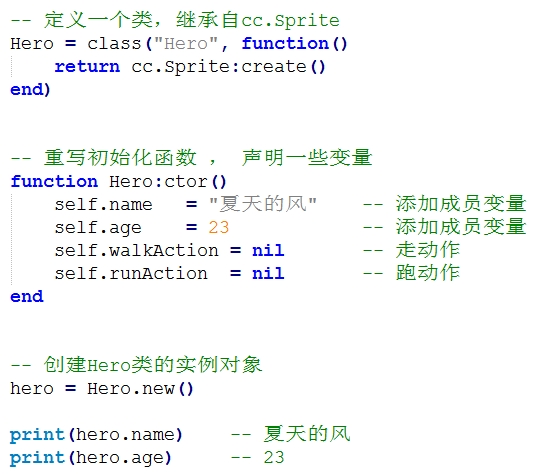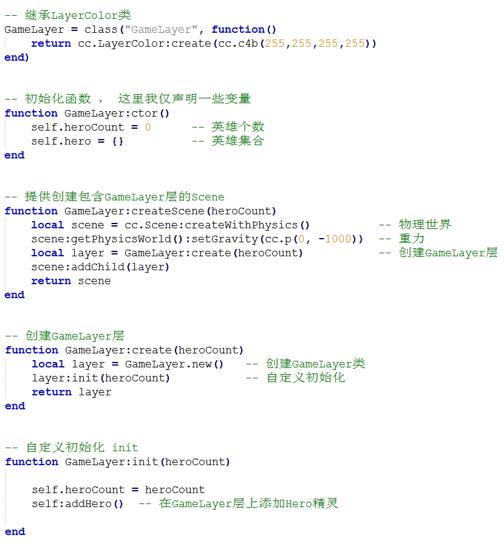Lua(3) ——Cocos之_语法糖c
发布时间:2019-09-20 07:36:53编辑:auto阅读(2356)
【唠叨】
在使用Lua的时候,cocos2d-x为我们提供了一个 class(classname, super) 这个函数。
它可以让我们很方便的定义一个类,或者继承cocos2d-x的某个类。
PS:class()是cocos2d-x为我们封装的函数,本身Lua没有这个函数。
基于Lua 5.1。
【Demo下载】
https://github.com/shahdza/Cocos_LearningTest/tree/master/Lua%E4%B9%8Bclass%E7%B1%BB
【class】
class函数是在"cocos2d-x-3.2/cocos/scripting/lua-bindings/script/extern.lua"中定义的。
-- Create an class. function class(classname, super) local superType = type(super) local cls if superType ~= "function" and superType ~= "table" then superType = nil super = nil end if superType == "function" or (super and super.__ctype == 1) then -- inherited from native C++ Object cls = {} if superType == "table" then -- copy fields from super for k,v in pairs(super) do cls[k] = v end cls.__create = super.__create cls.super = super else cls.__create = super end cls.ctor = function() end cls.__cname = classname cls.__ctype = 1 function cls.new(...) local instance = cls.__create(...) -- copy fields from class to native object for k,v in pairs(cls) do instance[k] = v end instance.class = cls instance:ctor(...) return instance end else -- inherited from Lua Object if super then cls = clone(super) cls.super = super else cls = {ctor = function() end} end cls.__cname = classname cls.__ctype = 2 -- lua cls.__index = cls function cls.new(...) local instance = setmetatable({}, cls) instance.class = cls instance:ctor(...) return instance end end return cls end |
在Lua中类的概念就是table表,而上面的函数代码主要做的就是对父类super的表进行拷贝,然后再定义了两个函数 cls.new(...) 和 cls:ctor(...) 。如果我们不了解上面的代码,也是没有关系的,只要我们会使用它就够了。
0、使用方法
> 定义一个类:cls = class("类名","父类")
> 创建实例 :obj = cls.new()
> 初始化函数:cls:ctor() 在创建实例的时候,会自动调用
只要掌握这三步骤,对于我们cocos2d-x的开发已经够用了!
1、创建基类
首先创建一个Hero类,然后重写Hero类的初始化函数Hero:ctor() 。
再创建一个Hero类的实例对象Hero.new() ,会自动调用初始化函数Hero:ctor() 。
测试输出。
注意:其中ctor()中出现的 self 为实例对象本身,就相当于C++类中的 this 。

2、继承父类
在cocos2d-x开发中,经常需要继承引擎中的类,如Layer、Sprite等。
这里举例,将上面的Hero类修改一下,继承自Sprite。

3、再举个例子:继承Layer类
我一般习惯在 ctor() 中只声明一些类的成员变量。
然后再自定义一个函数 create() ,将 new() 进行封装,然后在 create() 中调用 init() 函数进行实例对象的初始化工作。
这样的好处就是:在使用上就和我在C++中的使用的方式一样了。
3.1、定义一个继承于Layer的类

3.2、使用方法
> 创建包含GameLayer层的Scene场景:GameLayer:createScene()
> 创建一个GameLayer层-----------:GameLayer:create()
> 而在创建GameLayer时,也会调用自定义的初始化函数 init()
> 类的成员变量,均在 ctor() 中进行声明即可。
上一篇: python rtsp
下一篇: H3C ISIS
- openvpn linux客户端使用
51747
- H3C基本命令大全
51431
- openvpn windows客户端使用
41842
- H3C IRF原理及 配置
38612
- Python exit()函数
33108
- openvpn mac客户端使用
30099
- python全系列官方中文文档
28770
- python 获取网卡实时流量
23768
- 1.常用turtle功能函数
23681
- python 获取Linux和Windows硬件信息
22047
- Ubuntu本地部署dots.ocr
79°
- Python搭建一个RAG系统(分片/检索/召回/重排序/生成)
2277°
- Browser-use:智能浏览器自动化(Web-Agent)
2969°
- 使用 LangChain 实现本地 Agent
2473°
- 使用 LangChain 构建本地 RAG 应用
2418°
- 使用LLaMA-Factory微调大模型的function calling能力
3018°
- 复现一个简单Agent系统
2426°
- LLaMA Factory-Lora微调实现声控语音多轮问答对话-1
3232°
- LLaMA Factory微调后的模型合并导出和部署-4
5326°
- LLaMA Factory微调模型的各种参数怎么设置-3
5148°
- 姓名:Run
- 职业:谜
- 邮箱:383697894@qq.com
- 定位:上海 · 松江
